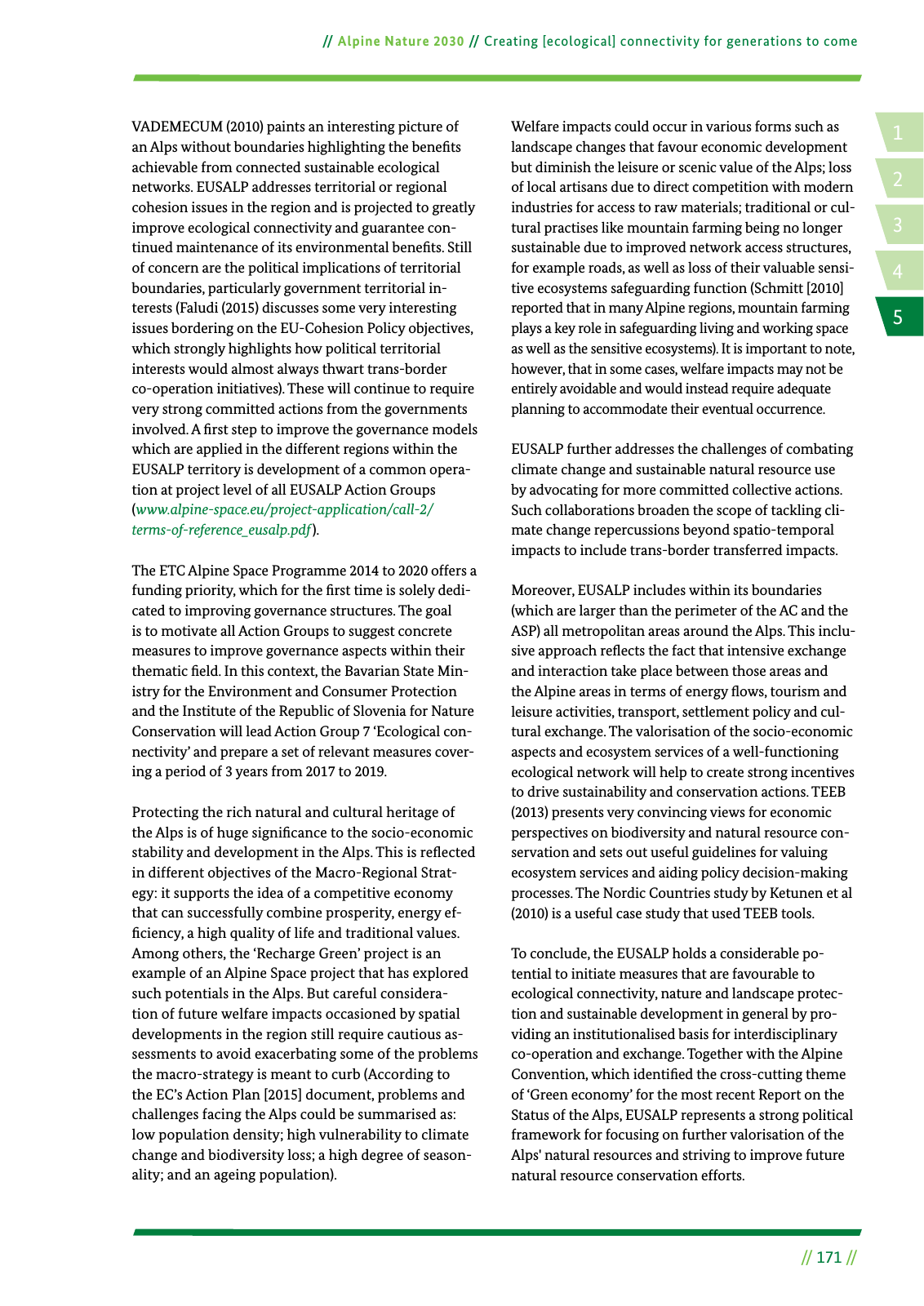14 2 5 3 Alpine Nature 2030 Creating ecological connectivity for generations to come 171 VADEMECUM 2010 paints an interesting picture of an Alps without boundaries highlighting the bene ts achievable from connected sustainable ecological networks EUSALP addresses territorial or regional cohesion issues in the region and is projected to greatly improve ecological connectivity and guarantee con tinued maintenance of its environmental bene ts Still of concern are the political implications of territorial boundaries particularly government territorial in terests Faludi 2015 discusses some very interesting issues bordering on the EU Cohesion Policy objectives which strongly highlights how political territorial interests would almost always thwart trans border co operation initiatives These will continue to require very strong committed actions from the governments involved A rst step to improve the governance models which are applied in the different regions within the EUSALP territory is development of a common opera tion at project level of all EUSALP Action Groups www alpine space eu project application call 2 terms of reference eusalp pdf The ETC Alpine Space Programme 2014 to 2020 offers a funding priority which for the rst time is solely dedi cated to improving governance structures The goal is to motivate all Action Groups to suggest concrete measures to improve governance aspects within their thematic eld In this context the Bavarian State Min istry for the Environment and Consumer Protection and the Institute of the Republic of Slovenia for Nature Conservation will lead Action Group 7 Ecological con nectivity and prepare a set of relevant measures cover ing a period of 3 years from 2017 to 2019 Protecting the rich natural and cultural heritage of the Alps is of huge signi cance to the socio economic stability and development in the Alps This is re ected in different objectives of the Macro Regional Strat egy it supports the idea of a competitive economy that can successfully combine prosperity energy ef ciency a high quality of life and traditional values Among others the Recharge Green project is an example of an Alpine Space project that has explored such potentials in the Alps But careful considera tion of future welfare impacts occasioned by spatial developments in the region still require cautious as sessments to avoid exacerbating some of the problems the macro strategy is meant to curb According to the EC s Action Plan 2015 document problems and challenges facing the Alps could be summarised as low population density high vulnerability to climate change and biodiversity loss a high degree of season ality and an ageing population Welfare impacts could occur in various forms such as landscape changes that favour economic development but diminish the leisure or scenic value of the Alps loss of local artisans due to direct competition with modern industries for access to raw materials traditional or cul tural practises like mountain farming being no longer sustainable due to improved network access structures for example roads as well as loss of their valuable sensi tive ecosystems safeguarding function Schmitt 2010 reported that in many Alpine regions mountain farming plays a key role in safeguarding living and working space as well as the sensitive ecosystems It is important to note however that in some cases welfare impacts may not be entirely avoidable and would instead require adequate planning to accommodate their eventual occurrence EUSALP further addresses the challenges of combating climate change and sustainable natural resource use by advocating for more committed collective actions Such collaborations broaden the scope of tackling cli mate change repercussions beyond spatio temporal impacts to include trans border transferred impacts Moreover EUSALP includes within its boundaries which are larger than the perimeter of the AC and the ASP all metropolitan areas around the Alps This inclu sive approach re ects the fact that intensive exchange and interaction take place between those areas and the Alpine areas in terms of energy ows tourism and leisure activities transport settlement policy and cul tural exchange The valorisation of the socio economic aspects and ecosystem services of a well functioning ecological network will help to create strong incentives to drive sustainability and conservation actions TEEB 2013 presents very convincing views for economic perspectives on biodiversity and natural resource con servation and sets out useful guidelines for valuing ecosystem services and aiding policy decision making processes The Nordic Countries study by Ketunen et al 2010 is a useful case study that used TEEB tools To conclude the EUSALP holds a considerable po tential to initiate measures that are favourable to ecological connectivity nature and landscape protec tion and sustainable development in general by pro viding an institutionalised basis for interdisciplinary co operation and exchange Together with the Alpine Convention which identi ed the cross cutting theme of Green economy for the most recent Report on the Status of the Alps EUSALP represents a strong political framework for focusing on further valorisation of the Alps natural resources and striving to improve future natural resource conservation efforts

Hinweis: Dies ist eine maschinenlesbare No-Flash Ansicht.
Klicken Sie hier um zur Online-Version zu gelangen.
Klicken Sie hier um zur Online-Version zu gelangen.